V.I. Fisinin and K.V. Zlochevskaya
In 1980 there are about 6.6 million adult ducks in the socialized sector in the Soviet Union. Their most important product is meat but to a small extent fat livers are produced. The distribution according to breeds and their numbers are shown in Table 15.1
Table 15.1 BREEDS OF DUCK IN THE SOVIET UNION
| Number of adult birds | ||
| Breed | 1974 |
1980 |
| Indian Runner |
|
few |
|
Moscow White |
few | |
|
Muscovy |
few | |
|
Pekin |
4 358 000 | |
|
Russian Decoy |
|
few |
|
Speculum |
400 |
few |
|
Ukrainian Clay |
360 | |
|
Ukrainian Grey |
17 700 |
2200 |
|
Ukrainian White |
26 700 |
6800 |
|
White-breasted Black |
218 |
190 |
|
Commercial ducks |
2 202 000 | |

A breed developed in India for egg production. It was imported from Britain, and selected intensively in the USSR. At present small flocks of these birds are raised by amateur poultrymen and on private plots in the south of the Russian Federation, in Uzbekistan and in Kazakhstan.
In appearance Indian Runners differ considerably from other ducks. The body is narrow; the legs are penguin-like; the head is small, with a large, wedge-shaped bill; the neck is long and thin; the wings are close to the body; the tail is raised; the legs are long; the shanks and feet are orange. The plumage can be white, pied, black or ash-red.
The ducks of this breed are noted for their high egg production, of some 200 eggs with records up to 365 eggs per year. Egg laying begins at the age of 5 or 6 months. The eggs are white and weigh 70-80 g. The live weight of drakes is 2.0 kg and that of ducks is 1.7-1.8 kg. The 60-day-old ducklings average 1.5 kg.
Indian Runner ducks have been crossed with other breeds to obtain crossbreds with high egg production and good meat qualities. On Lebyazhi state farm in Krasnodar territory Indian Runners were crossed with Pekin ducks. The work on the development of a new population named Kuban ducks was continued on Dinski state farm. In appearance Kuban ducks resemble Indian Runners, particularly in the shape of the body and the length of the legs.
Kuban ducks have a high live weight; the drakes average 3.0 kg and the ducks 2.7 kg. The live weight of the 60-day-old ducklings is 1.8-2.0 kg. Egg production is lower than that of Indian Runners - 130-150 eggs per cycle.
At present Kuban ducks are raised by amateur poultrymen and on private plots in Krasnodar territory.
Indian Runners and Kuban ducks are viewed as a genetic resource. A gene conservation flock of Indian Runners is maintained at the Kazakh Regional Experimental Poultry Station.
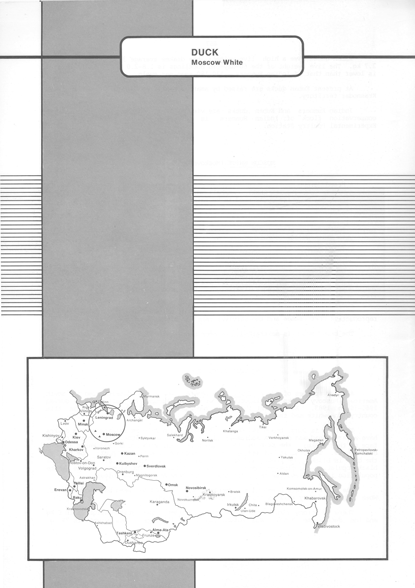
A breed group developed on Ptichnoe poultry state farm in Moscow region by crossing Pekin ducks with Khaki Campbell drakes to obtain ducks with good egg production. Moscow White ducks used to be raised on a large scale in Moscow region, on state and collective farms in the Baltic republics, and in many regions of the central area. At present, small flocks are kept in central regions of the Russian Federation and in the Baltic republics, mainly on private plots and small poultry farms. Individual poultry farms raise crossbreds obtained by crossing Moscow White ducks with Pekin ducks.
In conformation Moscow White ducks are similar to Pekin ducks. The body is broad and raised, the breast rounded, the head small, the legs short and wide-set. The plumage is white. The bill, shanks and feet are pale.
The live weight of drakes is 3.9-4.2 kg and that of ducks is 3.0-3.5 kg. Individual birds have a higher live weight. Egg production is 120-130 eggs in the first production cycle. Egg weight is 90 g.
Moscow White ducks have good meat qualities, thin bones and white skin. The reproductive performance and the survival rate are high, 75 and 90% respectively.
The breed group is maintained in a gene conservation stock.
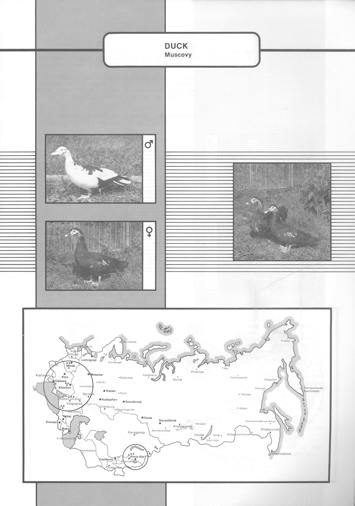
Another species of duck (Cairina moschata), which was domesticated in South America. Muscovy ducks were imported from western Europe in small numbers during 1960-70 and 1983. At present there are two populations of Muscovy ducks in this country, the white and the black.
The body is long, broad and deep; the head has a bulging forehead; the drakes have a large head and ducks a medium-sized one. There are featherless patches on the face of the drake; the skin in these spots is red, with folds and knobs at the bill's base. The bill is of medium length, skin-coloured or dark pink; the tip of the bill is black. The breast and the back are broad and the legs are long. In the black population the plumage, shanks and feet are black. The plumage of the white population is white and the skin, the shanks and feet are pale in colour.
The ducks of this breed have a peculiar gait, moving the head back and forward. When frightened they raise a feathered crest on the head.
There is strong sexual dimorphism in live weight. The drakes weigh up to 6 kg and the ducks some 3 kg.Egg production is 80-120 eggs.Egg weight is 70 g.
Fertility and hatchability are low. The French Grimaud firm has selected strains of the Muscovy duck with an egg yield of 140—150 eggs per layer. Crossbred obtained by crossing these strains weigh 3,8—4.0 kg at the age of 80 days.
One of the biological features of the Muscovy duck is a low fat content in the carcass of the young (22-26%), For this reason studies have begun using the Muscovy duck as a paternal line in crosses with the Pekin duck. These parents produce few offspring but carcass quality is high . The fat content is 10-15% less than in the carcass of pekin ducks.
Muscovy ducks are raised at the Byelorussian and Kazakh Regional Stations, in in Moldavia and in Krasnodar territory.
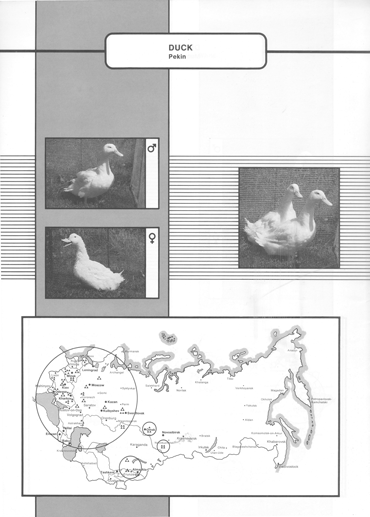
A breed developed. in China. In the USSR the introduction of the breed on a large scale began in 1920 and 1930s. At present broiler production is based mainly on crossbred from special strains of the pekin duck. in addition, Several populations have been developed on the basis of this breed which differ from it in their commercial characteristics.
The body is broad, long and somewhat raised.The breast Is broad and rounded. The head is large,the eyes are dark blue; the forehead is bulging; the bill is small and orange—coloured The back is broad; the wings are small, close to the body; the legs are short and thick. The plumage is white with, a yellowish—cream tinge.
The live weight of ducks of the special strains is high.The drakes weigh 4 kg or more and the ducks 3.5-3.7 kg. The 60-day-old ducklings weigh 2.8-3.2 kg and consume 2.9—3.3 kg of feed per kg of weight gain. The lines of the maternal strain nave a high egg production — 170-180eggs in the first cycle
These ducks have good meat qualities. The carcass accounts for 65-70% of the live weight. The yield of breast muscles Is 10—11% and that of all muscles 41—43%. However, the fat content of the carcass of the strains selected for rapid early weight gain is high. The skin with subcutaneous and visceral rat. accounts for 31-36% of the carcass or even more. Fertility and hatchability are 85—93% and 80—90% respectively.
The raising and extended breeding of Pekin ducks In closed flocks in various regions of the country have resulted in the isolation of some populations. The Chkalov population of Pekin ducks was developed at Chkalov breeding plant in Donetsk region. Breeding was aimed at increasing live weight and viability. The live weight of adult drakes reaches 3.8-4.0 kg and that of ducks is 3.4-3,6 kg. The live weight of 55-day-old ducklings is 2.4-2.5 kg. Egg production in the first cycle is 120-125 eggs. The Zhlobin population was selected on Zhlobin breeding state farm In Gome region. It Is based on Pekin ducks Into which some blood of Moscow White ducks was Infused; therefore the population has a high production - 160 or more eggs in the first production cycle. The Yagotinskaya population was selected on Yagotinskaya poultry farm in Kiev region. Within this population there are three groups. Within each group the paternal line has a higher live weight and the maternal line a better reproductive performance. The egg production of the maternal lines is 130 eggs in 5 months of production. Crossbreds obtained by crossing these lines weigh 2.4-2.5 kg at the age of 55 days.
These three populations differ from the special strains of the Pekin breed in their r higher reproductive performance and lower carcass fat content.
At present these populations exist in the gene conservation flocks of the Kazakh and Byelorussian Experimental Poultry Stations and are raised on private plots in the Ukraine and the Russian Federation. Plans envisage the preservation of these populations as genetic material for producing new maternal lines with better reproductive qualites.
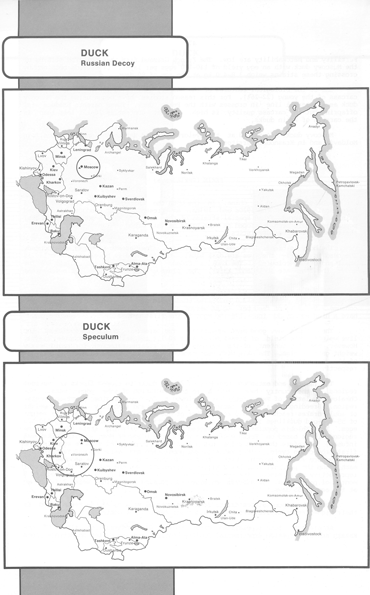
A breed developed by domesticating wild mallards followed by selection. They are used by hunters for enticing wild ducks.
In appearance Decoy ducks do not differ from mallards but there is greater variety in the plumage colour. The drakes have a head and a neck of greenish colour and an olive-green bill with a black tip. There is an enclosed white ring on the neck. The breast is dark brown and the back and wings are dark grey. There is a blue and green speculum on each wing. The lower part of the body is greyish white. The shanks and feet are orange. The ducks' plumage is very much like that of wild ducks.
The live weight of adult drakes is 1.4-1.5 kg and that of ducks is 1.3-1.4 kg. Egg production is low - 30-40 eggs; egg weight is also low - 50 g.
Russian Decoy ducks have a good stamina and high viability; they are good foragers and flyers. At present small flocks of these ducks are kept on specialized game farms and by amateur poultrymen.
A breed group of ducks obtained by complex crossing at Kuchinski breeding plant in Moscow region. Local breeds, Khaki Campbells, and Pekin ducks were used for crossing. The population of Speculum ducks at the Moscow Agricultural Academy was obtained by breeding inter se crossbreds of local ducks and Khaki Campbells. This breed is raised only on a limited scale. In 1974 there were some 400 birds on experimental farms. At present, small flocks are kept on private plots and by amateur poultrymen.
The body is deep, broad and long. The head is small and elongated, with a dark bill. The neck is of moderate length, slightly curved. The breast is broad, rounded and slightly protruding. The back is broad and erect. The tail is short and narrow. The wings are close to the body. The legs are short; the shanks and feet are orange. The male has a dark head and neck, shot with blue and green and a red collar; the breast is reddish brown and the body is light grey. The ducks have very light brown, almost white plumage. Both drakes and ducks have wing specula.
The average live weight of drakes is 3.3-3.5 kg and that of ducks is 2.8-3.0 kg. The egg production of Speculum ducks used to be higher than that of Pekins. In individual flocks it varied from 130 to 200 eggs per duck. The eggs are white and average 80 g in weight. The hatching rate is 70% or more. The production period lasts 8-9 months. The survival rate of both young and adult birds is high - 98-99%.
The breed group was developed under extensive conditions; the young were raised at low temperatures to obtain a population with a high viability. At the same time highly-productive birds were selected; therefore Speculum ducks have a high viability and good meat qualities. The dressing percentage is 89% and the yield of edible parts is 64% of the carcass.
Speculum ducks constitute germ plasm for developing maternal forms with a high egg production.
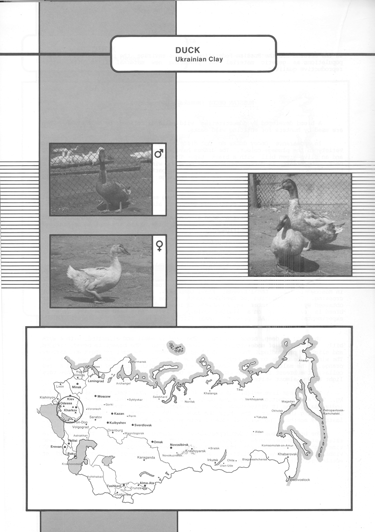
A breed group of limited distribution developed at the Ukrainian Poultry Breeding Institute from local ducks. Small flocks are kept on private plots and at the farm of the Institute. There were 360 birds in 1980; current data are not available.
In appearance Ukrainian Clay ducks are similar to Ukrainian Grey ducks. The head and the neck of the drakes are of dark chestnut-brown colour, shot with bronze; the bill is light olive-coloured; the breast and the body are brown, light on the lower part of the body and darker on the back. The shanks are orange-red. The ducks have a chestnut-brown head with two dark stripes; the bill is dark olive-coloured; the neck and body are light brown, yellow in summer. The shanks are of the same colour as in the male.
The economic value of the breed group is similar to that of the Ukrainian White but egg production and the live weight of the young are lower. Egg production is 120-125 eggs per cycle. The birds mature at the age of 6 months. The live weight of 5-month-old drakes is 3.0 kg and that of ducks is 2.8 kg. The 50-day-old ducklings weigh almost 2.0 kg. Egg weight is 78-80 g and the hatching rate is 65-70%.
Fertility and hatchability are 88-90 and 68-72% respectively. The survival rate of the ducklings is 94% and that of adult birds is 96%. Ukrainian Clay ducks have good adaptability to local conditions and a low carcass fat content'. The breed group is maintained in a gene conservation flock. The reduction in numbers is due to the introduction of the more productive Pekin ducks which are raised both on commercial poultry farms and on small private plots. At present Ukrainian Clay ducks are raised on Borki Experimental Farm of the Ukrainian Poultry Breeding Institute and by farmers in Kharkov and other regions of the Ukraine.
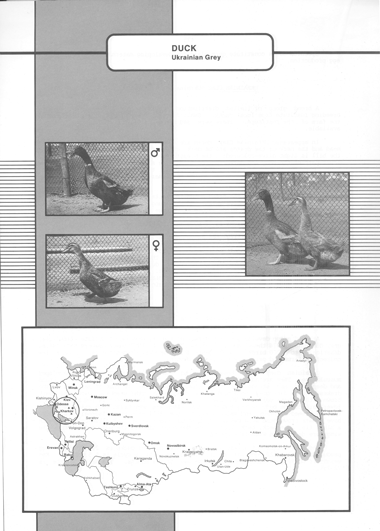
A breed group developed at the Ukrainian Poultry Breeding Institute from local grey ducks. In 1974 these ducks numbered 17 700; by 1980 their numbers had fallen drastically to 2200 birds. At present Ukrainian Grey ducks are raised on a few collective farms and private plots in the Ukraine.
Ukrainian Grey ducks have a strong constitution with a well-developed musculature. They are active and good foragers. They have a small head; a broad and deep body, and strong legs. The plumage is similar to that of mallards. The drakes have a dark grey or almost black head, shot with greenish colour, or dark brown with a white collar. The back is black-brown; the breast is red-brown; the lower part of the body is light grey. The wings are grey-brown with iridescent blue specula framed by black and white stripes; the bill is olive-coloured. The ducks have a dark brown head with two black stripes; the bill is dark olive-coloured, with a black tip. The neck, back, breast and the lower part of the body are brown; the wings are dark brown with blue specula.
The live weight of drakes is 3.3 kg and that of ducks is 2.9-3.0 kg. Egg production is 110-120 eggs per cycle. The duration of a cycle is 5.5 months. Egg weight is 80-90 g. Ducks mature at the age of six months. The hatching rate is 72-75%.
Ukrainian Grey ducks have sufficiently fast gains in the young and good viability. The 50-day-old ducklings weigh 2.3-2.4 kg and their survival rate is 95-96%. The survival rate of adults is 96-97%.
The considerable reduction in numbers of Ukrainian Grey ducks is due to the introduction of crosses of the Pekin duck with higher productivity and faster gains in the young. The breed group is maintained in a gene conservation flock.
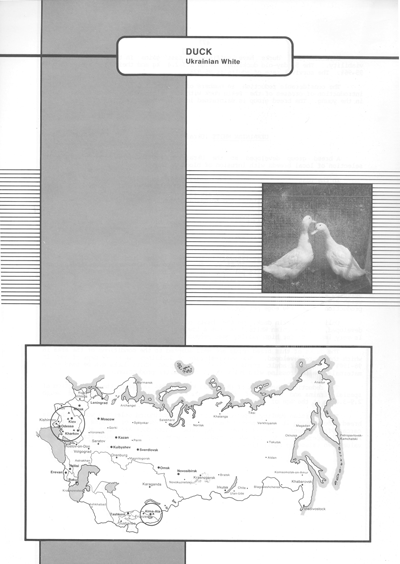
A breed group developed at the Ukrainian Poultry Breeding Institute by selection of local breeds with infusion of blood of the Pekin duck.
In the past this breed group was widespread. In 1974 Ukrainian White ducks numbered 26 700 birds; by 1980 their numbers had fallen to 6800. At present there is approximately the same number; they are raised on state and collective farms and on private plots in the Ukrainian and Moldavian republics.
The birds have a strong constitution and a small, slightly elongated head; the body is horizontal, long and broad, somewhat raised in front. The legs are short; shanks and feet are orange. The plumage is white. The drakes have a light yellow bill and the ducks have a dark yellow one.
The live weight of 5-month-old birds reaches 3.3 kg in drakes and 3.0 kg in ducks. Egg production is 120-130 eggs in the first cycle; the duration of the cycle is 5.5 months. Egg weight is 80-85 g. The 50-day-old ducklings weigh 2.O-2.1 kg; feed consumption is 3.3-3.4 kg per kg of gain. The hatching rate is good - 75-78%.
On the basis of this breed group the Ukrainian Poultry Breeding Institute has selected strains with higher productivity. The 49-day-old ducklings of these strains weigh 2.5-2.6 kg with 3.0-3.1 kg of feed consumed per kg of gain. Their egg production is 140-150 eggs per cycle.
Unlike the Pekin duck, on the basis of which commercial crosses have been developed, the Ukrainian White duck has a lower carcass fat content (22-24%), which is very important for high-quality meat production.
The ducks of this breed group are well adapted to the conditions of the area in which they were developed.The survival rate of ducklings up to 49 days of age is 98-100% and that of adult birds is 96-97%. Ukrainian White ducks can be used as a maternal line in crossing with Pekin ducks for broiler production.
The reduction in numbers of Ukrainian White ducks is due to the introduction of special strains and crosses of the Pekin duck, which have faster gains and weigh 2.9-3.0 kg at the age of 49 days.
The Ukrainian Poultry Breeding Institute is continuing selection work with this breed group using it as genetic material for development of strains with a low carcass fat content. Two strains of Ukrainian White duck are kept at the Kazakh Regional Experimental Station where studies are under way to determine its commercial value when raised in small flocks.
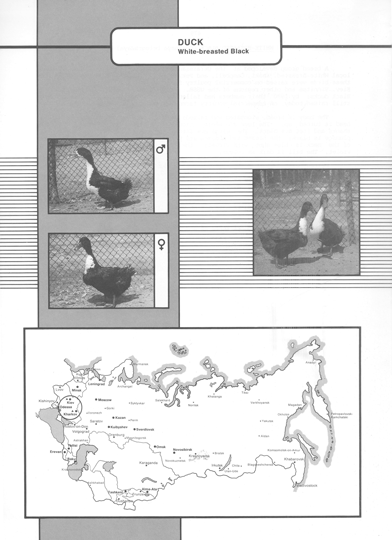
A breed group developed at the Ukrainian Poultry Breeding Station by crossing local White-Breasted, Khaki Campbell, and Pekin ducks. In the past the flocks of these birds were raised on commercial poultry farms and on private plots in Kharkov, Kiev, Vinnitsa and other regions of the USSR. In 1974 there were 218 White-breasted Black ducks; by 1980 their numbers had fallen to 190. Nearly the same number are still raised today, on commercial poultry farms and on farmers' private plots.
The body is broad, elongated and raised; the breast is broad and the elongated head is turned up. The legs are short, close to the rear, and moderately thick; shanks and feet are black. The wings are strong and small, close to the body. The plumage is black; the breast and abdomen are partly white. In drakes the upper part of the neck is blue shot with violet; the wing specula are shot with green or violet. The bill is dark in colour.
White-breasted Black ducks have adequate productivity. The live weight of the drakes is 3.6-3.8 kg and that of the ducks is 3.0-3.3 kg. The 60-day-old ducklings weigh 2.0 kg. Egg production is 120-130 eggs. Birds mature at the age of 6 months. The eggs are white and weigh 80-90 g. The survival rate of ducklings is 90-92% and that of adults is 95-96%.
White-breasted Black ducks have a high viability; they are good dabblers. The fertility and hatchability are 94 and 63-65% respectively.
White-breasted Black ducks serve as a genetic reserve for developing new breeds and strains for semi-extensive conditions.